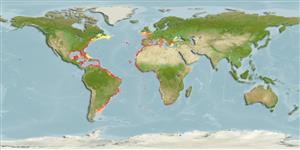Common names from other countries
Environment: milieu / climate zone / depth range / distribution range
Ecologia
marinhas; estuarina associadas(os) a recifes; intervalo de profundidade 1 - 100 m (Ref. 26999). Subtropical; 52°N - 45°S, 98°W - 36°E
Eastern Atlantic: English Channel to Angola, including the Mediterranean, Madeira, and the Azores. Western Atlantic: Canada (Ref. 5951) to Massachusetts, USA and the Gulf of Mexico to Argentina.
Comprimento de primeira maturação / Tamanho / Peso / Idade
Maturity: Lm 19.5 range ? - ? cm
Max length : 50.0 cm SL macho/indeterminado; (Ref. 6544); common length : 38.0 cm TL macho/indeterminado; (Ref. 3397); peso máx. publicado: 1.8 kg (Ref. 4699)
Descrição suscinta
Chaves de identificação | Morfologia | Morfometria
Espinhos dorsais (total) : 7; Raios dorsais (total) : 8; Espinhos anais: 0; Raios anais : 6. Pectoral fin very large and fan-like, with front 6 rays separated as small lobe (Ref. 26938).
Found on sand, mud or over rocks in sandy areas, exploring the bottom with the free part of the pectoral fins (Ref. 6544). Feeds primarily on benthic crustaceans, especially crabs, clams and small fishes. Neither anterolateral glandural groove nor venom gland is present (Ref. 57406).
Ciclo de vida ou comportamento de acasalamento
Maturities | Reprodução | Spawnings | Egg(s) | Fecundities | Larvas
Eschmeyer, W.N. and L.J. Dempster, 1990. Dactylopteridae. p. 690-691. In J. C. Quero, J. C. Hureau, C. Karrer, A. Post, and L. Saldanha (eds.) Check-list of the fishes of the eastern tropical Atlantic (CLOFETA). JNICT, Lisbon; SEI, Paris; and UNESCO, Paris. Vol. 2. (Ref. 10782)
Status na Lista Vermelha da UICN (Ref. 130435)
CITES (Ref. 128078)
Not Evaluated
Ameaça para os humanos
Harmless
Uso pelos humanos
Pescarias: pouco comercial; peixe esportivo: sim; Aquário: Espécies comerciais
Ferramentas
Relatórios especiais
Baixar XML
Fontes da internet
Estimates based on models
Preferred temperature (Ref.
115969): 13.3 - 27.8, mean 23.9 (based on 1072 cells).
Índice de diversidade filogenética (Ref.
82804): PD
50 = 1.0078 [Uniqueness, from 0.5 = low to 2.0 = high].
Bayesian length-weight: a=0.00977 (0.00739 - 0.01292), b=2.98 (2.90 - 3.06), in cm Total Length, based on LWR estimates for this species (Ref.
93245).
Nível Trófico (Ref.
69278): 3.7 ±0.5 se; based on diet studies.
Resiliência (Ref.
120179): médio(a), tempo mínimo de duplicação da população 1,4 - 4,4 anos (Preliminary K or Fecundity.).
Fishing Vulnerability (Ref.
59153): Moderate vulnerability (37 of 100).
